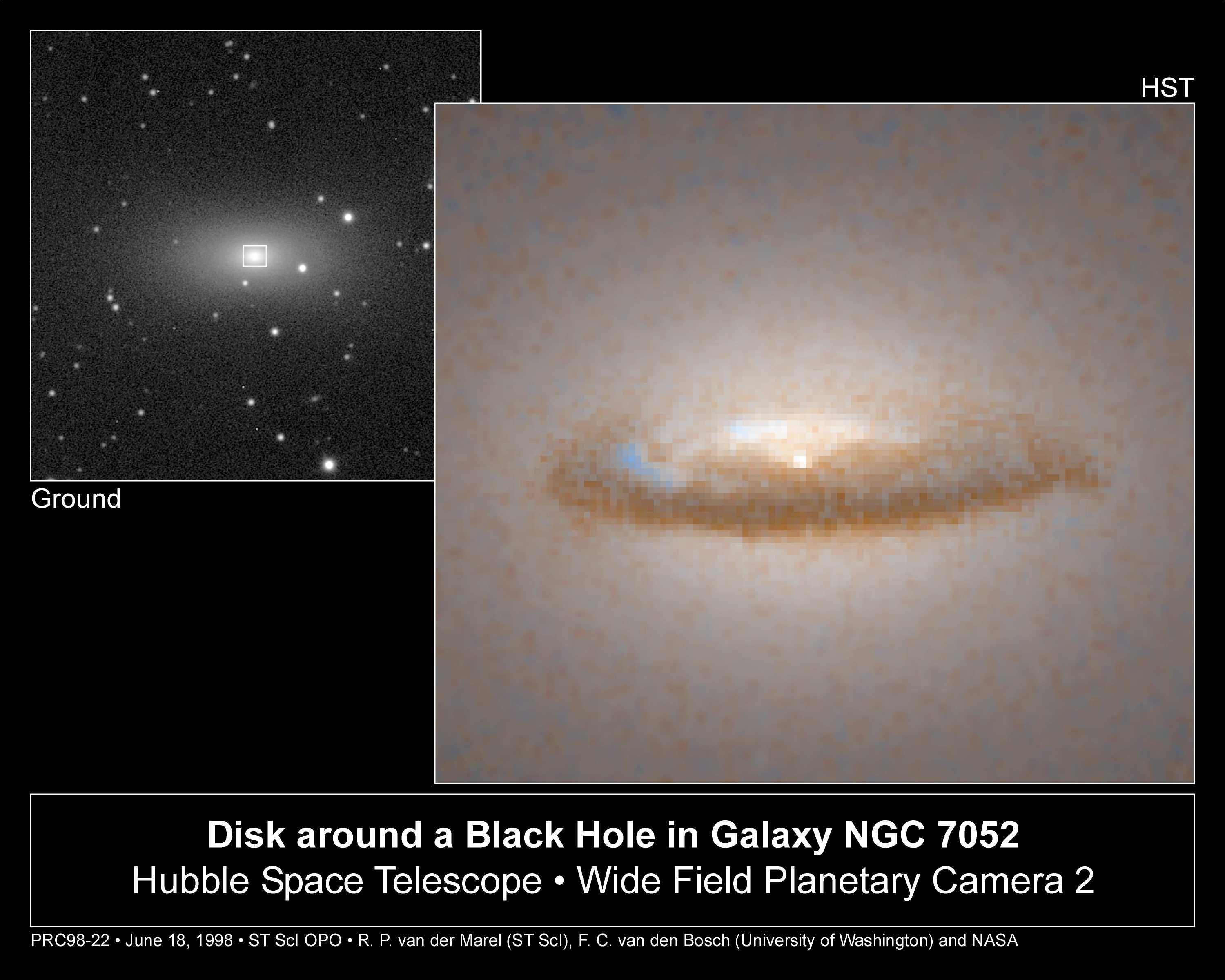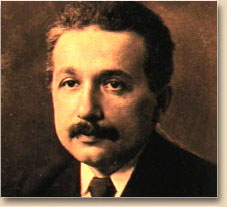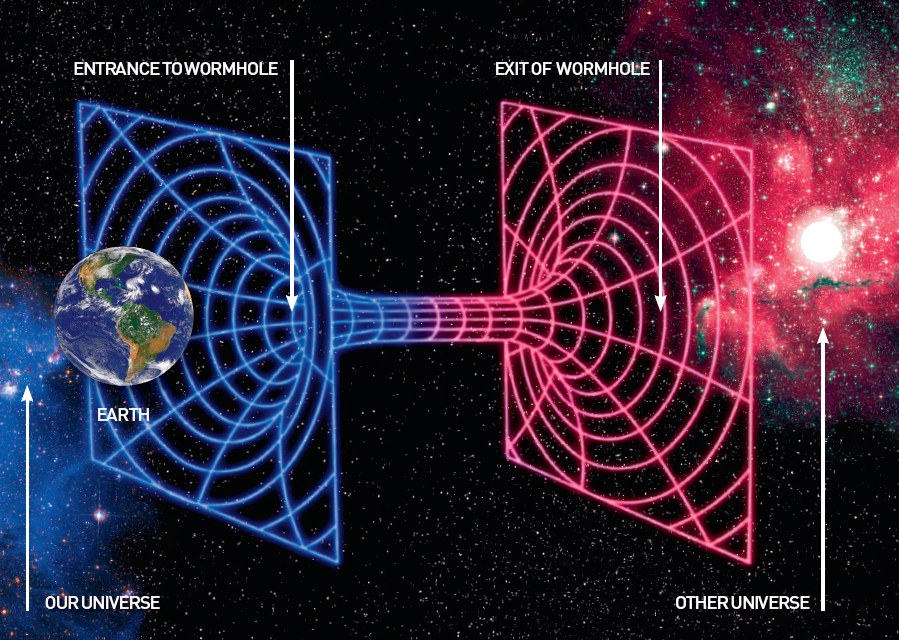Black HolesAt the end ... gravity always wins! |

Resembling a gigantic hubcap in
space, a 3,700 light-year diameter dust disk encircles a huge 300 million solar mass black
hole in the center of the elliptical galaxy NGC 7052.
Black Holes:
At the end gravity always
wins! Gravity drives the star into its final compact state. If
the star reaches this state with a mass of less than
1.4 solar
masses (the Chandrasekhar limit) then
quantum-mechanical pressure from the electrons will support
the white-dwarf star. If, however, the mass of the star
exceeds the Chandrasekhar limit, then it might become a
neutron star with the quantum pressure being provided by the
neutrons. Yet, the most sophisticated calculations to date
suggest that a neutron star cannot be more massive than
2-3 solar masses. So what happens to stars that reach
their final stage in their evolution with masses that
exceed 3 solar masses? Of course, they become Black Holes. To understand what we mean by a black hole let
us consider:
A simple example involving gravity:
Suppose that Roger Clemens or Alex Rodriguez (who signed a
10-year $252 million contract = $2.52x109) throws a baseball straight up in the air.
Even Clemens, powerful as he is, or Rodriguez, rich as he is,
will not be able to defeat gravity: the baseball will rise for
a while, but eventually gravity will stop it and will make it
start falling down again. The minimum speed at which Clemens
needs to throw the baseball so that it will never come back is
called the "escape
velocity." The Earth's escape velocity is almost 11
kilometers per second (or about a colossal 25,000 mph). Even
though this sounds like a large number, it is only a very
small fraction of the speed of light (c=300,000 km/sec). Even
a bullet from a shotgun is ten
times too slow!!
As you might imagine, the
escape velocity is determined by Newton's law of gravity,
which says that the force exerted on an object (such as a
baseball) by another object (such as the Earth) is directly
proportional to the masses but inversely proportional to (the
square of) the distance between the objects. In this way, the
escape velocity of an object is given by: V2=2GM/R, where G is Newton's gravitational constant, M
is the mass of the Earth, and R is the distance between
baseball and the Earth (note that the escape velocity of the
baseball does not depend on the mass of the baseball).
| Astronomical Object | Mass (kg) | Distance (km) | Escape velocity (km/sec) |
| Earth | 6x1024 | 6,400 | 11 |
| Sun | 2x1030 | 700,000 | 610 |
| Neutron Star | 4x1030 | 10 | 230,000 |
| Black Hole | 8x1030 | 1 | 1,000,000 > 300,000 |
From this table one can see that the escape velocity for an object at the surface of a typical neutron star is very close to the speed of light. For a slightly more compact object - such as one with a mass of 4 solar masses and a radius of 1 km - the escape velocity will exceed the speed of light! This is impossible, according to Einstein's Special Theory of Relativity: no material object (such as a photon, electron, proton, you, car, planet) can travel faster than light. Therefore, any material that "orbits" a black hole in such a way that its escape velocity exceeds the speed of light will be trapped forever. Such a compact object from which no material can escape is called a Black Hole.
Adding velocities according to Einstein:

Suppose you are standing on the platform of a train station and you observe a villain with a very powerful rifle fire a bullet at the incredible speed of one percent of the speed of light or v=30,000 km/s. Now imagine that you want to compute, still standing on the platform, the speed of the bullet as the train starts to move in the same direction as the bullet. Einstein has come up with another fantastic relativistic formula on how to add velocities:
V = (v + u)/(1 + v*u) (all velocities are relative to the speed of light c=300,000 km/s)
|
|
|
|
|
|
|
|
|
|
|
|
|
|
|
|
|
|
|
|
|
|
|
|
In 1783 the Rev. John Michell, a Cambridge professor and amateur astronomer, was the first person to suggest that, according to Newton's law of gravity, a star that was sufficiently massive and compact would exert such a powerful gravitational pull that not even light would be able to escape.
In 1915 Albert Einstein introduced: The General Theory of Relativity. In this theory - unlike in that of Newton - gravity is no longer a force. Rather, it is the curvature of space and time - or spacetime - that make objects move the way they do. In this theory planets move around the Sun the way they do because of the way spacetime is warped in their vicinity.

According to the general theory of relativity theory if any object, such a star, is squeezed below a certain critical radius then gravity will overwhelm all known forces and the object will be crushed without limit to a singularity. The critical radius is called the Schwarzschild radius, in honor of Karl Schwarzschild who,
in 1916, found the first solution to Einstein's equations, in which was later interpreted as that of a stationary black hole. Schwarzschild found this solution within months of Einstein's publication of his equations. Remarkably, Schwarzschild did this work while a frontline soldier on World War I. Sadly, shortly after his impressive calculations, Karl Schwarzschild was killed in action at the front (this bullet was going too fast!)

A more "intuitive" explanation of the Schwarzschild radius is the distance from the center of a black hole at which the escape velocity is exactly equal to the speed of light. From our previous equation V2=2GM/R we can easily compute the value of the Schwarzschild radius to be equal to: Rs=2GM/c2. For example, for the Sun its Schwarzschild radius is about 3 km. We conclude that the Sun (whose radius is 700,000 km) would have to be crushed into a sphere of a radius less than or equal to 3 km for the Sun to become a black hole. A black hole with a mass of 50 million solar masses would have a Schwarzschild radius of 1AU. Such a black hole would just fit - and engulf everything - within the Earth's orbit! Schwarzschild radius defines a one-way boundary, or "membrane", that separates the inside of the black hole from the rest of the Universe. This boundary, which is not made of any material, is called the event horizon. All events that occur inside the boundary are forever hidden from us. Therefore, in a real sense the inside of a black hole is disconnected from the rest of the universe in both space as well as in time.
| Object | Mass (kg) | Schwarzschild radius (km) |
| Human | 100 | 1.5 x 10-28 (much smaller than a proton!) |
| Earth | 5.974 x 1024 | 0.9 x 10-5 (about 10 mm) |
| Sun | 1.989 x 1030 | 3 (smaller than Tallahassee) |
Do Black Holes Really Exist? You bet they do!!
Black holes are so strange, that for a long time they were thought to be just a theoretical curiosity. Of course, black holes are very difficult to detect because they are totally invisible, as nothing can escape from their event horizon. One could detect, however, the influence of the black hole on its environment. For example, if matter from a companion star flows into the black hole X-rays will be emitted from the matter outside the event horizon. Thus, one wants to search for black holes among X-ray binaries. So it is not the black hole that we detect, it is its influence of its nearby environment.

In 1970 a very powerful
X-ray source - Cygnus
X-1 - was discovered
8000 light years from us. This source contains a supergiant O
star and a compact object orbiting each other with a period of
5.6 days. The compact object - if a black hole - is of course
invisible to us, but analysis of Doppler shifts reveal
information about the motion of the O supergiant star around
the center of mass of the binary system. This information,
together with Kepler's third law [(m1+m2)=a3/p2]
suggest
a
mass for the compact object of between 10-15 solar masses,
well above the maximum 2-3 solar masses for a neutron star.
With such a large mass squeezed into such a small a volume
(less than the size of the Earth) the best explanation for
Cygnus X-1 is a black hole. Yet, conclusive evidence about
Cygnus X-1 being a black hole is still lacking. However, the
search for solid evidence in favor of black
holes continues, using very
sophisticated equipment such as the HST.
Wormholes:
So far, we have only
considered ordinary "vanilla" black holes. Specifically, we
have been talking all along about black holes that are not
rotating and have no electric charge. If we consider black
holes that rotate and/or have charge, things get more
complicated. In 1935, Albert Einstein and Nathan Rosen
discovered solutions of Einstein's equations that they
interpreted as bridges between different parts of spacetime.
Today we call these Einsten-Rosen bridges, Wormholes. A
conveniently-located wormhole would therefore provide a
convenient and rapid way to travel very large distances, or
even to travel to another Universe. Maybe the exit to the
wormhole would lie in the past, so that you could travel back
in time by going through. All in all, they sound pretty cool.
But before you get too excited, just because something is a
valid mathematical solution to the equations doesn't mean that
it actually exists in nature. Moreover, even if wormholes
exist and are stable, they are quite unpleasant to travel
through. Radiation that pours into the wormhole (for example
from nearby stars) gets blue shifted to very high frequencies.
Hence, as you (or Jodie Foster) try to pass through the
wormhole, you will get fried by these X-rays and gamma rays.
Wormholes are now becoming popular because of the movie
Contact, which is based in the book by Carl Sagan of the same name.



 ge the past and therefore also
change the present? In 1949 Kurt Godel discovered a
solution of Einstein's equation that described a rotating
spacetime. Einstein was very disturbed by the fact than in such
rotating spacetimes a spaceship could go off on a journey and
return before it takes off; that is, that his theory of general
relativity allowed the possibility of time travel! One of the problems with time travel is the
so-called "grandparent" paradox. Suppose
you are moving through a wormhole that takes you backwards in
time where you kill one of your grandparents before he or she
has any children. Could you do this and not, in doing so,
eliminate your own existence? And even if you do that, then no
one killed your grandparent in the first place and your birth is
possible again! At this point we do not know whether or not such
spacetimes structures can exist in our universe. Perhaps,
because we have no compelling evidence of visitors from our
future, who presumably would have had enough time to develop
time travel, we can assume that no such spacetime
structures exist in the part of the universe to which, in
principle, we have access to. Again, not because a mathematical
solution to the equations is possible that means that the
physical situation is attainable. But
you never know ...
ge the past and therefore also
change the present? In 1949 Kurt Godel discovered a
solution of Einstein's equation that described a rotating
spacetime. Einstein was very disturbed by the fact than in such
rotating spacetimes a spaceship could go off on a journey and
return before it takes off; that is, that his theory of general
relativity allowed the possibility of time travel! One of the problems with time travel is the
so-called "grandparent" paradox. Suppose
you are moving through a wormhole that takes you backwards in
time where you kill one of your grandparents before he or she
has any children. Could you do this and not, in doing so,
eliminate your own existence? And even if you do that, then no
one killed your grandparent in the first place and your birth is
possible again! At this point we do not know whether or not such
spacetimes structures can exist in our universe. Perhaps,
because we have no compelling evidence of visitors from our
future, who presumably would have had enough time to develop
time travel, we can assume that no such spacetime
structures exist in the part of the universe to which, in
principle, we have access to. Again, not because a mathematical
solution to the equations is possible that means that the
physical situation is attainable. But
you never know ...